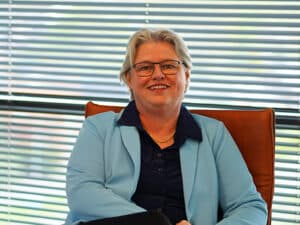
ECSA names its first female president
The European Community Shipowners Association (ECSA) has appointed its first female president. Karin Orsel stepped into the role for a two-year term on January 1, succeeding Philippos Philis on the conclusion of

The European Community Shipowners Association (ECSA) has appointed its first female president. Karin Orsel stepped into the role for a two-year term on January 1, succeeding Philippos Philis on the conclusion of
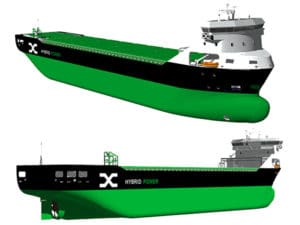
Sweden’s AtoB@C Shipping, a subsidiary of Aspo Group’s ESL Shipping, has declared an option for an additional electric-hybrid ice class 1A bulker from Indian shipyard Chowgule & Company Private Limited. AtoB@C placed
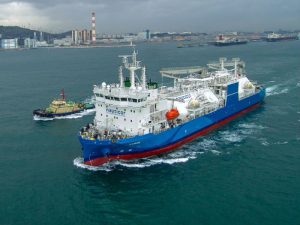
OCTOBER 26, 2018 — Finland’s ESL Shipping Ltd. has signed a long term contract with Hamburg based Linde Group subsidiary Nauticor GmbH & Co. KG for the supply of LNG in the
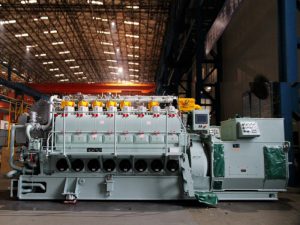
NOVEMBER 29, 2017 — MAN Diesel & Turbo’s dual-fuel MAN L23/30DF engine successfully passed its Type Approval Test (TAT) earlier this month at CSSC Marine Power (CMP) in Zhenjiang in the presence
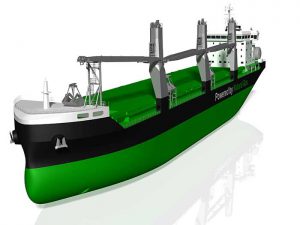
JUNE 28, 2017 – The two LNG-fueled handysize bulkers ordered by Finland’s ESL Shipping (see earlier story) will be fitted with MacGregor bulk handling cranes with an autonomous discharging feature. MacGregor, part
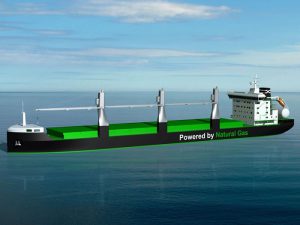
SEPTEMBER 27, 2016 — The two LNG-fueled handy sized bulkers ordered by Finland’s ESL Shipping last November (see earlier story) will now be built at Sinotrans & CSC main yard, Jinling Shipyard,
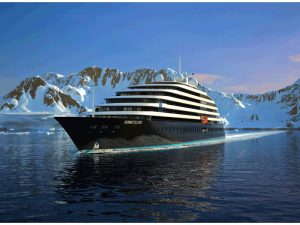
Soon, noon-day reporting from fallible human beings will be a thing of the past. From cradle to grave, a whole new approach to ship efficiency has been made possible by recent advances in IT and data processing. Now, a step change in “always-on” ship connectivity will allow maritime assets to be monitored and managed remotely right round the clock.
As we reported in “Shipping’s Space Age Future” (ML April 2016, p. 37), perhaps the most ambitious project on the go in Europe is the Rolls-Royce-led Advanced Autonomous Waterborne Applications Initiative (AAWAI) in which other maritime firms including DNV GL, Inmarsat, Deltamarin and NAPA are also involved. Other participants include top academics from various Finnish universities.
At a project update meeting recently in Helsinki, Rolls-Royce President – Marine, Mikael Makinen declared: “Autonomous shipping is the future of the maritime industry. As disruptive as the smart phone, the smart ship will revolutionize the landscape of ship design and operations.”
Delegates heard that the sensor technology is now sufficiently sound and commercially available so that algorithms required for robust decision-making—the vessel’s virtual captain—are not far away. Now the arrays of sensors are to be tested over the coming months on board Finferries’ 65-meter-long double-ended ferry, Stella.
“Some of the distinct goals of this project are to make a difference in marine safety and energy efficiency,” Päivi Haikkola, Manager, R&D, Deltamarin Ltd., told Marine Log. “We want to mitigate human error.”
Finferries and dry bulk shipping company ESL Shipping Oy are the first ship operators to join the project, which aims to explore ways in which to combine existing communication technologies as effectively as possible for autonomous ship control. Inmarsat’s involvement is key.
The London-listed communications company recently began the roll-out of its new Fleet Xpress service, seen by many as truly a light-bulb moment. Preparing the ground for rapid advances in smart ship operation and crew welfare, the new service now provides always-on high-speed broadband communication between maritime and offshore assets at sea, and shore-based managers. It is the first time that such a service has been available from a single operator.
Fleet Xpress will also facilitate cloud-based applications from third parties with smart systems to raise ship operating efficiency and improve the life-quality of seafarers. For the first time, big data can be used to improve asset management and maintenance.
IT advances have also facilitated a new approach to ship design. Model basins and testing tanks still have their place, of course, but thousands of relatively high-speed computational iterations can measure the relative benefits of small design changes in a way that has not been possible before.
Take the Finnish company Foreship, for example. Its capabilities in computational fluid dynamics (CFD) and the super-efficient hull forms which it has developed have propelled the company into a position as one of the top ship design consultants to global cruise lines, advising both on newbuilding plans, conversions and retrofits.
In a couple of months, the first of two 4,700 dwt “EcoCoaster” cargo ships is due for delivery to Finland’s Meriaura Group from the Royal Bodewes yard in the Netherlands. Foreship carried out extensive hull optimization work and, as a result, these vessels will burn only about half of the fuel compared to an existing vessel of similar size and class.
Foreship worked with both the owner and Aker Arctic Technology on the ships which will be able to run on biofuel or marine gasoil. Meriaura plans to have at least half of its fleet – currently about 20 ships – based on EcoCoaster designs by 2020. Since ordering the 4,700 dwt units, work has been carried out on larger designs.
Also hailing from Finland is progressive ship design firm Deltamarin. Now a subsidiary of Singapore-listed AVIC International Maritime Holdings Limited and ultimate Chinese ownership, the company’s range of super-efficient B.delta bulk carriers spanning a size range from 28,000 dwt to 210,000 dwt has caught the attention of long-established dry bulk owners including heavyweights such as Algoma, Canada Steamship, Cosco, Louis Dreyfus Armateurs and Oldendorff.
Of course the catalyst for taking a fresh look at the hull forms which had not changed for decades was the spike in bunker prices. But although the oil price collapse means today’s fuels cost only a fraction of prices two or three years ago, the search for improved economy has developed a momentum of its own, and nowhere is this more obvious than amongst leading propulsion companies, many of which are to be found in Europe.
While big low-speed diesel manufacturers like MAN Diesel & Turbo and Wärtsilä have made huge strides in raising the fuel efficiency of large engines, it is among some of the smaller niche machinery providers where true design innovation is to be found. Electrical power, energy storage and the growing popularity of azimuth thrusters are fiercely fought-after markets. ABB, Rolls-Royce, Steerprop, and Wärtsilä all feature in a market popular with operators of cruise ships, workboats, offshore support vessels and dynamically positioned offshore units of various types.
ABB, for example, recently won a European Marine Engineering Award for its Azipod D electric propulsion system with a power range from 1.6MW to 7MW. Launched last year, the latest Azipod was designed to allow its use on a wider range of ship types. It incorporates various innovative features including a new hybrid cooling system which contributes to a requirement for 25% less installed power and similar fuel savings.
The first cruise ship with Azipod D will be the 16,800 gt Scenic Eclipse being built by Uljanik shipyard in Croatia. The Scenic Eclipse (pictured above) is being built to Polar Class 6 and will operate in the summer waters of the Polar regions when it is delivered in 2018. The 228-passenger ship will have two 3MW Azipods installed.
Meanwhile, ABB recently announced a deal to supply a new electrical power system based on its Onboard DC Grid system for a hybrid car ferry in Norway. Initially the vessel, for Torghatten Trafikkselskap will operate as a hybrid with two battery packs contributing to peak demand. However, the 60-car, 250-passenger vessel can be easily modified to become fully electric in due course by adding 16 battery packs and a shore connection.
For the cruise ship and offshore vessel markets, Wärtsilä recently unveiled the Wärtsilä WTT-40 transverse thruster, which features a 4,000 kW power level and a 3,400 mm diameter controllable pitch propeller. The thruster complies with the U.S. EPA’s latest VGP2013 regulations. It also features integrated hydraulics to save machinery room space and installation and commissioning time in the shipyard.
Meanwhile, last year Steerprop Ltd. landed orders for a total of ten SP25D units to serve as main propulsion for three inland towboats being built for SCF Marine at C&C Marine & Repair, Belle Chasse, LA. The propulsors will be delivered this summer to the shipyard by Karl Senner, LLC., Kenner, LA, the North American distributor for Steerprop. These will be the largest and highest horsepower inland towboats equipped with Z-drives built in North America to date, according to Chris Senner of Karl Senner, LLC. He adds, “It is imperative to consider the harsh conditions of the inland waterways and select a unit suited for the environment, which is why we propose the equivalent of an ice-class rated unit.”
A new generation of much more fuel and operationally efficient newbuilds, however, does nothing for the tens of thousands of existing vessels built before the new wave of design innovation began. But there are a range of initiatives in progress focused on enhancing existing ship efficiency.
 Germany’s Becker Marine Systems is a leading light in energy-efficient retrofits and appendages. The company recently signed a deal with Abu Dhabi’s Adnatco to fit some 20 vessels with Becker Mewis Ducts (pictured at right). Rudder modifications and Becker Twisted Fins are also generating a steady pipeline of sales.
Germany’s Becker Marine Systems is a leading light in energy-efficient retrofits and appendages. The company recently signed a deal with Abu Dhabi’s Adnatco to fit some 20 vessels with Becker Mewis Ducts (pictured at right). Rudder modifications and Becker Twisted Fins are also generating a steady pipeline of sales.
Walter Bauer, Sales Director, concedes that sales volume has reduced. But he says that this is partly a result of the dire state of the bulk carrier market. Tanker business, he says, is holding up well.
But what to do with almost-obsolete panamax container ships? Owing to beam constraints, they are generally long and relatively thin, and were mostly built in an era of cheap fuel and fast sailing speeds. They are not particularly efficient from a box-carrying point of view, but are in dire straits today, competing with larger ships and lower slot costs. There are more than 800 such vessels in the world fleet today and well over half are less than 10 years old. They are likely to prove increasingly unpopular with charterers.
Cargo access specialist MacGregor is one of several companies which offers capacity increasing conversions for container ships. By slicing a vessel in half lengthways, a newly constructed midship section can be inserted and stack heights raised by lifting the navigation bridge.
In a similar project, the capacity of the 4,860 TEU MSC Geneva, owned by Reederei NSB, was increased to 6,300 TEU. The five-month widening project, undertaken in close cooperation with Hamburg’s Technology GmbH, was completed at Huaran Dadong Dockyard in China. Through its subsidiary NSB Marine Solutions, Reederei NSB is now offering to assist in similar projects for third parties.
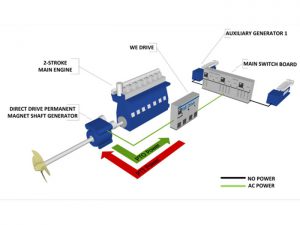
MAY 10, 2016 — The two LNG dual-fueled 25,600 dwt bulkers ordered by Finland’s ESL Shipping at the Qingshan Shipyard in China (see earlier story) will have WE Tech Solutions direct-drive permanent
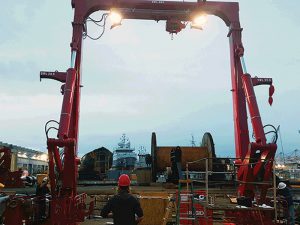
With the goal of improving the safety and capability of the marine research industry, Allied Marine Crane, a division of Allied Systems Company, has developed the A-Stern A-Frame. Hydraulically powered, the A-Frame is used to launch and recover trawls, dredges, and ROVs. Its crossbeam rotates freely as it deploys, ensuring that the load—the unit has a 30,000 to 40,000 lb dynamic load capacity—and lighting are properly oriented throughout the entire range of motion.
Last year, the innovative unit was successfully fitted onto the R/V Sikuliaq. The vessel, owned by the National Science Foundation and operated by the University of Alaska Fairbanks School of Fisheries and Ocean Sciences, conducts oceanographic and fisheries related research in polar and sub-polar regions.
Allied says, the A-30 Stern A-Frame’s maintenance position allows crew to access the crossbeam from the deck at a standing height furthering safety during setup and rigging.
The provider also supplied the U.S. Navy’s Office of Naval Research vessels the 238 ft Neil Armstrong and Sally Ride with two sets of crane components. The Neil Armstrong is being operated by the Woods Hole Oceanographic Institution, while the Sally Ride is currently operating for the Scripps Institution of Oceanography at the University of California San Diego.
Under the contract, the company designed and manufactured an identical set of handling equipment for each vessel. The units consisted of a davit; the Stern A-frame; a telescoping knuckle-boom crane; a starboard side handling system and a CTD handling system—both of which extend all the way to the waterline for more stability when loading; a portable telescoping knuckle-boom crane—among the first of its kind in the industry, the unit can be bolted down to a standard UNOLS mounting pattern anywhere on deck and can be removed when its not needed; and two hydraulic power units.
 BREAKING INTO A NEW NICHE
BREAKING INTO A NEW NICHE
Rapp Marine U.S. has taken a huge innovative step forward, developing, what its President Johann Sigurjonsson calls “an ideal tow winch for the market.” Having long been a developer and supplier of electric and hydraulic driven mooring winches, anchor windlasses, capstans, and cranes, Rapp Marine worked closely with Baydelta Navigation Ltd. to develop a towing winch that would be long lasting and dependable for the tug market.
Rapp Marine is supplying a unique, fully electric driven double drum tow winch for a new 110 ft x 40 ft tractor tug operated by Vessel Chartering LLC, a wholly owned division of Baydelta Navigation Ltd. The tug was designed by Seattle-based Jensen Maritime and will be built at JT Marine Shipyard, Vancouver, WA.
The winch, the first fully electric driven tow winch delivered by Rapp Marine, will be able to pull over 75 tons and use pneumatic cylinders in place of hydraulics—to keep fluid off the deck.
According to Rapp Marine, the winch will be driven by a single 100 hp electric motor with the ability to clutch in and out each winch drum. The clutches and brakes will be actuated remotely through either control panels or manually on the winch.
The winch will be primarily controlled in the wheelhouse using Rapp Marine’s Pentagon Tow Control System, which provides for a more efficient and safer operations for towing vessels. The system includes Auto Tensioning, automated haul-in and pay-out settings, in addition to touchscreen displays showing tension and wire length.
Rapp Marine says the winch can store up to 2,500 ft of 2.5 inches of Steel Wire Rope and 90 ft of 3 inch chain on the storage drum. The unit will also include a 10 HP electric “come home” drive. The drive can be used as a back up if the main motor should fail.
SELF-ALIGNING ESCORT WINCH
No stranger to innovation, the man behind the innovative training tug, the BRAtt, Captain Ron Burchett, and his company, Burchett Marine, recently delivered three new scale model tugs to Warsash Maritime Academy in Southampton, UK.
The 8,000 hp, 42m ASD tug models were equipped with the latest winch technology from JonRie InterTech—including a JonRie’s patented self-aligning escort winch.
During testing of the winch at the Academy, the model was able to stop a 44 ft long containership model at a speed of 10 knots. Captain Burchett will return to the Academy later this summer for Round 3 of testing at the 12 to 15 knot range.
The winch, says JonRie, was redesigned to accommodate a new 3-speed Hagglunds motor—this would allow for faster retrieval speeds. The motor will have the capability to free wheel each individual cam ring which comes complete with JonRie’s Render Blocking enabling render speeds to exceed 120 m/min. The tug’s dynamic stability was further enhanced by the righting lever supplied by the winch.
The winch’s hydraulic braking system is rated for 300 tonnes.
Additionally, the winch, explains JonRie’s Brandon Durar, is bolted to its rotating foundation to help prevent distortion to the drive from welding. The winch also contains a load tension read out system and JonRie’s foot control for a hands-free operation.
MACGREGOR WINS CONTRACTS FOR ESL SHIPPING CARRIERS
MacGregor, part of Cargotec, recently won a contract to deliver hatch covers, cranes, deck machinery and steering gear to two 25,600 dwt dual-fueled handysize bulk carriers being built for Finland’s ESL Shipping at China’s Sinotrans & CSC Shipbuilding Industry Cooperation’s Quingshan shipyard.
As part of the deal, MacGregor will provide three K3030-4 mechanical grab cargo cranes with a safe working load of 30 tonnes at 30 m outreach. Additionally, the group will provide the design and key components package for multi folding-type hatch covers (6+6), electrically-driven Hatlapa deck machinery and Porsgrunn steering gear.
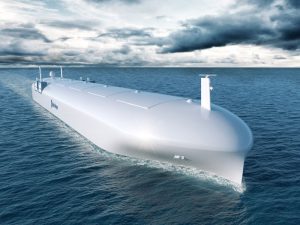
APRIL 12, 2016 — Two Finnish companies have become the first commercial operators to join the Advanced Autonomous Waterborne Applications Initiative (AAWA) project, led by Rolls-Royce. They are ferry operator Finferries and